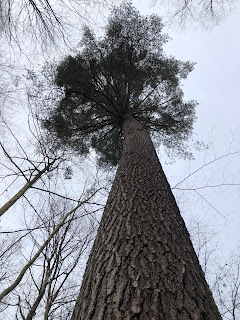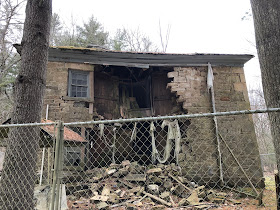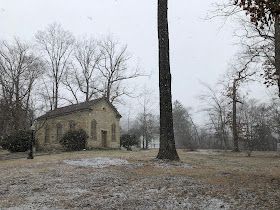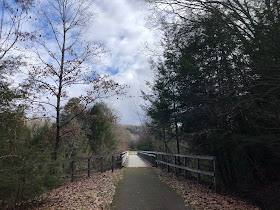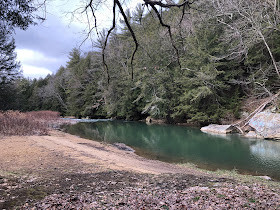I don’t know if the ridge I explored today is named Kelly Hill. My maps show its modest height at 1,733 feet, but they don’t give the lonely mountain a name. And yet, the narrow, paved lane that hugs the mountainside and leads up into this area is called Kelly Hill Road, so I’m assuming the road is named for the hill that it leads to.
I’m at my hunting camp to work on some writing projects, and I thought I’d bag the unnamed peak of what is probably Kelly Hill. My longstanding rule has been only to claim peaks that are higher than 2,000 feet, but the heights are less lofty up here than in the Laurel Highlands, although the trees are far grander and the land is much wilder. Today was true winter—23 degrees for most of my upland trek. It’s nice to have a real winter day for the Leap Year. I hiked just short of six miles.
This peak did not appear on the peak-bagging website where I log my climbs, so I submitted it to be added. I can’t claim it till they approve my submission, so I’m waiting. It’s so lovely to have a place within easy reach of the the Allegheny National Forest, the woodland that I love. Actually, my camp is surrounded by woods, but most of the forestland up here belongs to lumber companies, and it’s marked with No Trespassing signs (which I’m going to have to ignore someday).
Here’s the lonely summit of Kelly Hill. There are little dirt lanes in this part of the woods leading to oil wells. The signs at the oil wells say that they are located on Knupp Farm—which must be what this quadrant of the forest is named. A family named Knupp once worked these rocky highland ridges. It was surely a hard life. Instead of Kelly Hill, I thought it would be fun to dub this summit—pictured here—Knupp Knob, pronouncing the K in both words. The federal government purchased all this land in the 1920s to create a national forest in this place, but it did not buy the mineral rights, so there’s a lot of oil drilling here, except in protected zones.
The teaberries up here on Knupp Knob (or Kelly Hill) are huge, abundant, and flavorful. Most teaberries barely carry the faintest whiff of mint about them, but these are very minty. They’re called teaberries because their leaves were used to make an ersatz tea during the British tea embargoes during and after the Revolutionary War. You have to let the leaves sit in water for a few days, then remove them and heat the water. It’s drinkable. Another woodland tea can be made from pine needles.
Here’s the view from the top. Once again, there would be nothing but leaves in the summer. It’s such a joy to be back in the woods of Northern Pennsylvania. I could begin posting on my old blog again, The Allegheny Journal, which was dedicated to public lands up in this region, and which I had to all-but-abandon when we moved to Pittsburgh, lo these 14 years ago. When I lived up here, the old blog was actually pretty popular. I believe it was the only blog dedicated to the Allegheny National Forest...and might still be. An online travel magazine republished many of its articles. But that was long ago.
PS: The peak-bagging site did not approve my submission of Kelly Hill. Although is’t higher than many a high point in the Midwestern states, they said it did not have a summit. I’lll have to relish my achievement privately.










